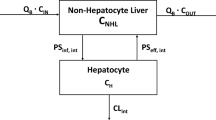Abstract
Flavone acetic acid (FAA) is an antineoplastic agent that has undergone extensive study in Phase I trials. Concentration-dependent plasma protein binding has been demonstrated in vitroconcentrations of total drug that are achieved in vivo.Moreover, dose-dependent total systemic clearance has been described when FAA has been administered as a short iv infusion. When administered as a prolonged 24-hr infusion, total FAA (bound plus unbound) plasma pharmacokinetics are well described with a first-order two-compartment model. However, measurement of unbound FAA intra- and post-intravenous infusion in eight patients revealed a twofold increase in fraction of FAA unbound in plasma intrainfusion. We attempted to fit pharmacokinetic structural models of varying complexity to the unbound concentrations alone and simultaneously to the unbound and bound FAA plasma concentrations. The data were adequately described only by a model that incorporated simultaneous saturable plasma protein binding and a Michaelis-Menten process for elimination. A comparison among models is presented, as well as pharmacokinetic parameter estimates for FAA in children. These clinical data are consistent with predictions of the clearance model in which both saturable protein binding (resulting in a dynamically increasing unbound fraction) and saturable elimination (resulting in gradually decreasing unbound intrinsic clearance) are operative.
Similar content being viewed by others
References
P. J. O'Dwyer, D. Shoemaker, D. S. Zaharko, C. Grieshaber, J. Plowman, T. Corbett, F. Valeriote, S. A. King, J. Cradock, D. F. Hoth, and B. Leyland-Jones. Flavone acetic acid (LM 975, NSC 347512): A novel antitumor agent.Cancer Chemother. Pharmacol. 19:6–10 (1987).
J. Cummings and J. F. Smyth. Flavone 8-acetic acid: Our current understanding of its mechanism of action in solid tumours.Cancer Chemother. and Pharmacol. 24:269–272 (1989).
C. B. Pratt, M. V. Relling, W. H. Meyer, E. C. Douglass, S. J. Kellie, and L. Avery. Phase I study of flavone acetic acid (NSC 347512, LM975) in patients with pediatric malignant solid tumors.Am. J. Clin. Oncol. 14:483–486 (1991).
R. B. Weiss, R. F. Green, R. D. Knight, J. M. Collins, J. J. Pelosi, A. Sulkes, and G. A. Curt. Phase I and clinical pharmacology study of intravenous flavone acetic acid (NSC 347512).Cancer Res. 48:5878–5882 (1988).
D. J. Kerr, S. B. Kaye, J. Cassidy, C. Bradley, E. M. Rankin, L. Adams, A. Setanoians, T. Young, G. Forrest, M. Soukop, and M. Clavel. Phase I and pharmacokinetic study of flavone acetic acid.Cancer Res. 47:6776–6781 (1987).
I. N. Olver, L. K. Webster, J. F. Bishop, and K. H. Stokes. A phase I and pharmacokinetic study of 12-h infusion of flavone acetic acid.Cancer Chemother. Pharmacol. 29:354–360 (1992).
J. Cummings, J. A. Double, M. C. Bibby, P. Farmer, S. Evans, D. J. Kerr, S. B. Kaye, and J. F. Smyth. Characterization of the major metabolites of flavone acetic acid and comparison of their disposition in humans and mice.Cancer Res. 49:3587–93 (1989).
J. Brodfuehrer, F. Valeriote, K. Chan, L. Heilbrun, and T. Corbett. Flavone acetic acid and plasma protein binding.Cancer Chemother. Pharmacol. 27:27–32 (1990).
J. Cassidy, D. J. Kerr, A. Setanoians, D. S. Zaharko, and S. B. Kaye. Could interspecies differences in the protein binding of flavone acetic acid contribute to the failure to predict lack of efficacy in patients?Cancer Chemother. Pharmacol. 23:397–400 (1989).
A. Gouyette, D. J. Kerr, S. B. Kaye, A. Setanoians, J. Cassidy, C. Bradley, G. Forrest, and M. Soukop. Flavone acetic: A nonlinear pharmacokinetic model.Cancer Chemother. Pharmacol. 22:114–119 (1988).
K. A. Havlin, J. G. Kuhn, J. B. Craig, D. H. Boldt, G. R. Weiss, J. Koeller, G. Harman, R. Schwartz, G. N. Clark, and D. D. Von Hoff. Phase I clinical and pharmacokinetic trial of flavone acetic acid.J. Nat. Cancer Inst. 83:124–128 (1991).
D. Z. D'Argenio and A. Schumitzky. A program package for simulation and parameter estimation in pharmacokinetic systems.Comput. Prog. Biomed. 9:115–134 (1979).
J. J. Lima, D. B. Haughey, and C. V. Leier. Disopyramide pharmacokinetics and bioavailability following the simultaneous administration of disopyramide and14C-disopyramide.J. Pharmacokin. Biopharm. 12:289–313 (1984).
K. M. Giacomini, S. E. Swezey, K. Turner-Tamiyasu, and T. F. Blaschke. The effect of saturable binding to plasma proteins on the pharmacokinetic properties of disopyramide.J. Pharmacokin. Biopharm. 10:1–15 (1982).
J.-D. Huang and S. Øie. Hepatic elimination of drugs with concentration-dependent serum protein binding.J. Pharmacokin. Biopharm. 12:67–81, (1984).
G. Levy and T. Tsuchiya. Salicylate accumulation kinetics in man.New Engl. J. Med 287:430–432 (1972).
J. G. Wagner. Time to reach steady state and prediction of steady-state concentrations for drugs obeying Michaelis-Menten elimination kinetics.J. Pharmacokin. Biopharm. 6:209–225 (1978).
D. E. Furst, T. N. Tozer, and K. L. Melmon. Salicylate clearance, the resultant of protein binding and metabolism.Clin. Pharmacol. Ther. 26:380–389 (1979).
J. H. Lin, K. F. Hooke, K. C. Yeh, and D. E. Duggan. Dose-dependent pharmacokinetics of diflunisal in rats: dual effects of protein binding and metabolism.J. Pharmacol. Exp. Ther. 235:402–406 (1985).
M. Mayersohn. Special pharmacokinetic considerations in the elderly. In W. E. Evans, J. J. Schentag, and W. J. Jusko (eds.),Applied Pharmacokinetics, 2nd ed., Applied Therapeutics, Inc., Spokane, WA, 1986, chap. 9.
M. Rowland, T. F. Blaschke, P. J. Meffin, and R. L. Williams. Pharmacokinetics in disease states modifying hepatic and metabolic function. In L. Z. Benet (ed.),The Effect of Disease States on Drug Pharmacokinetics, American Pharmaceutical Association, Academy of Pharmaceutical Sciences, Washington, DC., 1976, chap. 4 pp. 53–76.
Author information
Authors and Affiliations
Additional information
Supported by Cancer Center CORE Grant CA21765, Solid Tumor Program Project Grant NCI 5 PO1 CA 23099, by a Center of Excellence grant from the state of Tennessee, and Amercian Lebanese Syrian Associated Charities.
Rights and permissions
About this article
Cite this article
Relling, M.V., Evans, R.R., Groom, S. et al. Saturable elimination and saturable protein binding account for flavone acetic acid pharmacokinetics. Journal of Pharmacokinetics and Biopharmaceutics 21, 639–651 (1993). https://doi.org/10.1007/BF01113499
Received:
Revised:
Published:
Issue Date:
DOI: https://doi.org/10.1007/BF01113499




